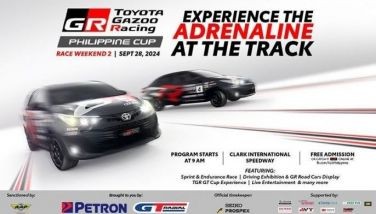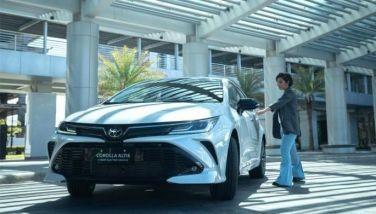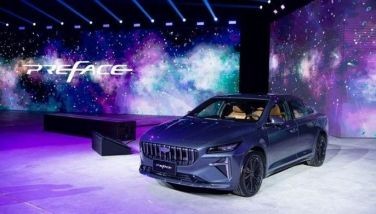Behind the wheel of the Peugeot 307
December 3, 2003 | 12:00am
I first saw the Peugeot 307 two years ago in the 2001 Tokyo Motor Show as it made its Japanese debut. Back then it was just one of those interesting European cars that were unfortunately not available in this country. Needless to say, I merely picked up a press kit and trooped off to the displays of car companies that were actually doing business in the Philippines.
Which goes to show just how dynamic the local car industry is today. That’s because, a mere two years later, I found myself behind the wheel of a 307, lent to me for a few days by AutoFrance Phils. Inc., the local Peugeot distributor.
The 307 was awarded the "European Car of the Year 2002" title by 55 journalists from 21 European nations. Over a million units have been sold since its 2001 European launch. My test car was a jet black 5-door 1.6-liter automatic transmission model, which costs P995,000 (the manual goes for P895,000).
As a motoring journalist, I get to drive newly launched cars all the time, sometimes even before they hit the showrooms. I find it already predictable how people react when they see a new Civic or Corolla. Unleash an all-new marque, however — especially one whose name is hard to pronounce (say "Poo-Joe") — and the effect is totally different, almost comical. I got a kick reading the lips of a group of friends eating at a McDonald’s as they tried to pronounce the name while I passed them on the drive-thru.
But more than the tongue-challenging name, it’s the gorgeous shape of the 307 — highlighted by characterful headlamps and taillamps and a sleek wedge profile — that kept heads turning and drivers of other cars tailgating to have a better look. For one thing it’s a fairly large hatchback; a mere eight inches shorter than the current Civic sedan but almost two inches wider and a whopping three inches taller than the Honda. Its wheelbase is also a mere half an inch shorter than the Civic’s. Lighter, brighter exterior colors would surely emphasize the lines and size of the 307 more than the black paint of my test car did. But there’s no doubt that this is a stylish looking car. In fact, like the smaller 206, when looked at as a whole — or its detailing is examined — the 307 has a wealth of wonderful touches.
Inside you’d never mistake the Peugeot for a Japanese car. Not from the very European look and feel of the thick-rimmed steering wheel, the no-nonsense dashboard layout, the hefty feel of the switchgear — right down to the smell. And thanks to the high roof and the lengthy wheelbase, cabin real estate is downright cavernous. Cargo space is quite generous too, as long as you don’t plan on carrying tournament-size golf bags on a regular basis. (You’d have to fold the rear seatbacks for that.) There are lots of cabin storage spaces with a sunglass holder and big door pockets and even an airconditioned glovebox!
There are no less than six airbags, plus climate control, power windows/mirrors/locks, an in-dash CD player/stereo with steering wheel stalk-mounted controls, and a trip computer. Other safety features include large and very effective automatic rain-sensing wipers and automatic headlights that turn themselves on at dusk and in other low-light conditions. But while I remember the old Renaults’ seats to be as soft as that of an easy chair, the seats of this modern French car is firm and supportive, almost like a German car’s.
On the road the 307 takes on an even more Germanic character. It’s no BMW, mind you, but more like an Opel, especially in the relaxed takeup of the accelerator, which requires a few inches of travel before the car gets going. At speed, the car’s European upbringing comes to the fore with a well-planted feel even in high-speed (70-80 kph) cornering coupled with a supple ride on uneven road surfaces — this despite an utterly conventional front strut/rear torsion beam suspension.
Engine power will never be described as overwhelming, but certainly adequate for local driving conditions. Braking is a strong suit, what with large disc brakes all around with ABS and Brake Assist (which helps in keeping the brakes applied hard during an emergency stop) being standard. Credit for the stable handling and strong braking performance also goes to the surprisingly large 16" wheels and wide 205/55R-16 Goodyear Eagle NCT5s.
All things considered, the 307 is a welcome and refreshing addition to the growing number of "niche" cars. At its price it’s definitely not a car for everyone. But for the discerning few who appreciate the finer points of things French, the 307 can indeed be automotive bliss.
Which goes to show just how dynamic the local car industry is today. That’s because, a mere two years later, I found myself behind the wheel of a 307, lent to me for a few days by AutoFrance Phils. Inc., the local Peugeot distributor.
The 307 was awarded the "European Car of the Year 2002" title by 55 journalists from 21 European nations. Over a million units have been sold since its 2001 European launch. My test car was a jet black 5-door 1.6-liter automatic transmission model, which costs P995,000 (the manual goes for P895,000).
As a motoring journalist, I get to drive newly launched cars all the time, sometimes even before they hit the showrooms. I find it already predictable how people react when they see a new Civic or Corolla. Unleash an all-new marque, however — especially one whose name is hard to pronounce (say "Poo-Joe") — and the effect is totally different, almost comical. I got a kick reading the lips of a group of friends eating at a McDonald’s as they tried to pronounce the name while I passed them on the drive-thru.
But more than the tongue-challenging name, it’s the gorgeous shape of the 307 — highlighted by characterful headlamps and taillamps and a sleek wedge profile — that kept heads turning and drivers of other cars tailgating to have a better look. For one thing it’s a fairly large hatchback; a mere eight inches shorter than the current Civic sedan but almost two inches wider and a whopping three inches taller than the Honda. Its wheelbase is also a mere half an inch shorter than the Civic’s. Lighter, brighter exterior colors would surely emphasize the lines and size of the 307 more than the black paint of my test car did. But there’s no doubt that this is a stylish looking car. In fact, like the smaller 206, when looked at as a whole — or its detailing is examined — the 307 has a wealth of wonderful touches.
Inside you’d never mistake the Peugeot for a Japanese car. Not from the very European look and feel of the thick-rimmed steering wheel, the no-nonsense dashboard layout, the hefty feel of the switchgear — right down to the smell. And thanks to the high roof and the lengthy wheelbase, cabin real estate is downright cavernous. Cargo space is quite generous too, as long as you don’t plan on carrying tournament-size golf bags on a regular basis. (You’d have to fold the rear seatbacks for that.) There are lots of cabin storage spaces with a sunglass holder and big door pockets and even an airconditioned glovebox!
There are no less than six airbags, plus climate control, power windows/mirrors/locks, an in-dash CD player/stereo with steering wheel stalk-mounted controls, and a trip computer. Other safety features include large and very effective automatic rain-sensing wipers and automatic headlights that turn themselves on at dusk and in other low-light conditions. But while I remember the old Renaults’ seats to be as soft as that of an easy chair, the seats of this modern French car is firm and supportive, almost like a German car’s.
On the road the 307 takes on an even more Germanic character. It’s no BMW, mind you, but more like an Opel, especially in the relaxed takeup of the accelerator, which requires a few inches of travel before the car gets going. At speed, the car’s European upbringing comes to the fore with a well-planted feel even in high-speed (70-80 kph) cornering coupled with a supple ride on uneven road surfaces — this despite an utterly conventional front strut/rear torsion beam suspension.
Engine power will never be described as overwhelming, but certainly adequate for local driving conditions. Braking is a strong suit, what with large disc brakes all around with ABS and Brake Assist (which helps in keeping the brakes applied hard during an emergency stop) being standard. Credit for the stable handling and strong braking performance also goes to the surprisingly large 16" wheels and wide 205/55R-16 Goodyear Eagle NCT5s.
All things considered, the 307 is a welcome and refreshing addition to the growing number of "niche" cars. At its price it’s definitely not a car for everyone. But for the discerning few who appreciate the finer points of things French, the 307 can indeed be automotive bliss.
BrandSpace Articles
<
>
- Latest
Latest
Latest
September 30, 2024 - 4:26pm
By EC Toledo | September 30, 2024 - 4:26pm
September 26, 2024 - 3:30pm
September 26, 2024 - 3:30pm
August 16, 2024 - 11:00am
By Euden Valdez | August 16, 2024 - 11:00am
Recommended
January 10, 2025 - 12:00am



























